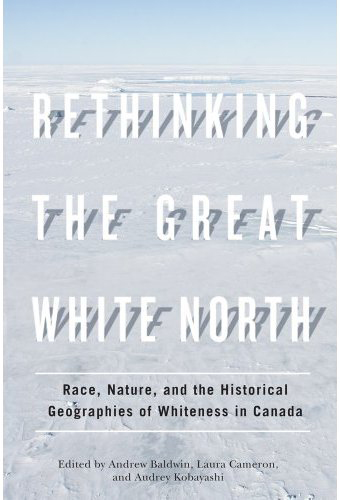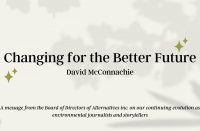Unlike most academic books, Rethinking the Great White North stirred enough irritation to be attacked by a Globe and Mail columnist. Repeating an old saw, Margaret Wente previously wrote that what makes someone Canadian is having sex in a canoe. Maybe new immigrants should be taught to canoe, Wente said, so they could be more patriotic.
Unlike most academic books, Rethinking the Great White North stirred enough irritation to be attacked by a Globe and Mail columnist. Repeating an old saw, Margaret Wente previously wrote that what makes someone Canadian is having sex in a canoe. Maybe new immigrants should be taught to canoe, Wente said, so they could be more patriotic.
The editors of this book took her to task in their introduction. They wrote that this perception, “Canada = Canoeing,” was just one of the ways a European colonial mentality permeates both our sense of nation and nature. Wente lashed back in the pages of the broadsheet. I hope environmentalists will listen better than she did.
When I came to Northern Saskatchewan as an immigrant, I quickly understood how much the North matters to the Canadian imagination. Nature and the boreal forest are huge parts of the country’s history and sense of identity. But I also learned that the “Canadian” way of thinking about the land was often split along ethnic lines. This book clearly shows how race and nature intermingle.
The view of the North as wilderness often neglects native peoples. The national narrative refers to, and then brushes over, the native present/presence. This is partially why the oil sands development proceeds as rapaciously as it does. They sort of say “there’s no one there,” so Canadians are willing to sacrifice the “empty” land.
For all our vaunted multiculturalism, Canada remains highly Euro-centric in modes of thinking and acting, how our institutions operate and even what counts as legitimate knowledge about the land. In the hands of the authors of these 14 sections, the Great “White” North becomes an analogy for the dominance of “whiteness” and the racial privilege that accumulates with it. The chapter on Temagami in Northern Ontario shows how Anglophone tourist literature labelled it a “wild” place. But what was a recreation site for southern Canadian tourists was a workplace for their Aboriginal guides. The “wilderness” was domestic. Contemporary ecotourism similarly celebrates exotic nature and cultures.
Two early chapters contrast the way “nature” was moralized around ethnicity. City planners in Toronto at the turn of the 20th century advocated the creation of parks to “civilize” and Canadianize new immigrants. Nature was “good.” The next chapter, an analysis of the rhetoric around Toronto’s SARS outbreak in 2005, demonstrates nature as “bad” or a threat. Media reports highlighted the virus’ origin in Asia, and as fear rose, nature – via SARS – became equated with the immigrants being a threat. Life-saving nurses were reframed as immigrant or ethnic nurses putting “us” at risk by possibly passing on the pathogen.
There are two chapters about Samuel Hearne’s Arctic travelogues and the way this 18th century explorer represented intertribal conflicts and economic exchanges. Hearne racialized his “Chipewyan” guides and shaped the image of bloodthirsty, uncivilized aboriginals. Dominant social positions come with the power to narrate the land and shape its management, use, development and protection.
Rethinking the Great White North addresses injustices in other parts of Canada. Catriona Mortimer-Sandilands illustrates the erasure of Acadian ethnicity from Cape Breton Highlands National Park and its subsequent replacement by the more respected Scottish ethnic heritage.
Elsewhere, conservation was a management tool for ethnic groups and ecosystems. Stephen Bocking, well known to readers of this magazine, describes how purportedly objective science minimizes traditional knowledge. The two differ dra-mat-ically in their epistemologies and their way of understanding ecological processes, so it is difficult, if not impossible, to test against each other. Science has often been an implement of racializing domination, even to the present day.
Rethinking the Great White North contains some of the complicated academic language that makes people avoid reading such books. But that would be a mistake. Even more detrimental would be to ignore the entwining of race, nature, ethnicity and colonization that still permeates Canadian society. We need to disrupt the narratives of nature that are too often used in environmental action.
This book’s unravelling of race and nature in history and geography might help environmental protection by opening a broader vision of just sustainability and expanding the pool of people who might help formulate it. This is one of several recent scholarly books that challenges Canadian environmentalism to expand its social justice credibility. Will doing so help the environment? Yes, because it makes us more aware. Sustainability is an impossible goal if it does not include social equity. If others don’t see their issues and efforts in the movement, we unnecessarily narrow the audience for environmental messages.
Rethinking the Great White North, ed. Andrew Baldwin, Laura Cameron and Audrey Kobayashi, Vancouver: UBC Press, 2011, 356 pages
This review originally appeared in Art & Media, Issue 38.3. Subscribe now to get more book reviews in your mailbox!
Reviewer Information
Randolph Haluza-DeLay is a former wilderness guide. He is an associate professor of sociology at The King’s University College in Edmonton.












